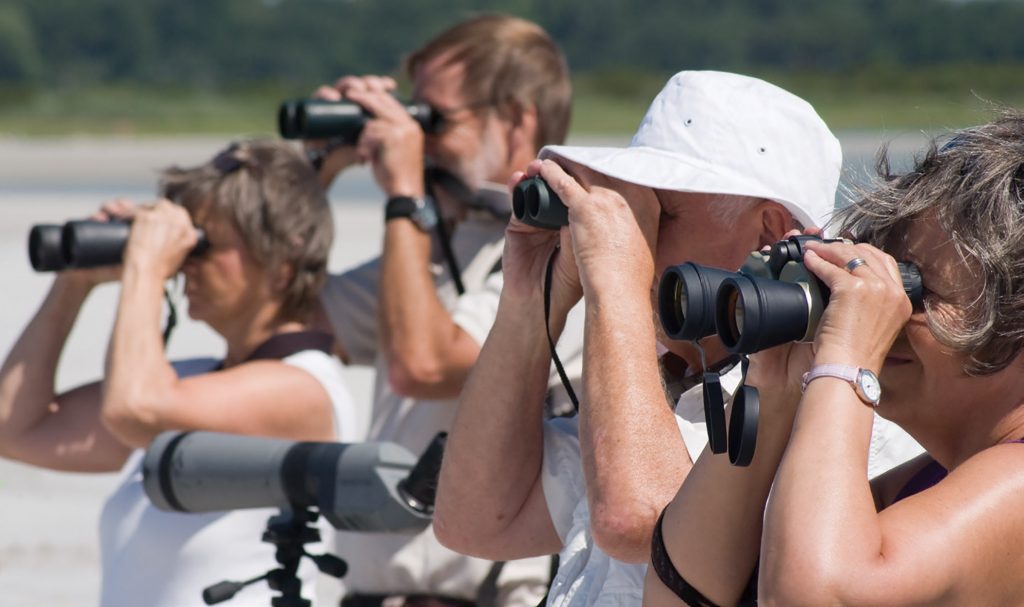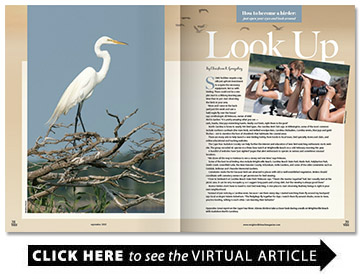Look Up
How to become a birder: just open your eyes and look around
BY Christine R. Gonzalez

Some hobbies require a significant upfront investment to acquire the necessary equipment. Not so with birding. There could not be a simpler start to a lifelong learning pastime than to just start observing the birds in your area.
“Mom and I were in the backyard just this week and saw a bald eagle fly over the house,” says ornithologist Jill Peleuses, owner of Wild Bird & Garden. “It is pretty amazing what you see — owls, hawks, blue jays mimicking hawks. Really cool birds, right there in the yard.”
North Carolina is home to nearly 500 bird types, the Carolina Bird Club says. In Wilmington, some of the most common include northern cardinals (the state bird), red-bellied woodpeckers, Carolina chickadees, Carolina wrens, blue jays and goldfinches – not to mention the host of shorebirds that habituate the coastal areas.
There are many aids to help launch a new birding hobby, from books to local tours, bird specialty stores and clubs, and online educational and tracking websites.
The Cape Fear Audubon Society can help further the interest and education of new bird-watching enthusiasts via its website. The group recorded 42 species in a three-hour watch at Wrightsville Beach on a cold February morning this year.
A handful of websites have “just sighted” pages that alert enthusiasts to species in various and sometimes unusual locations.
“We drove all the way to Hatteras to see a snowy owl one time,” says Peleuses.
Some of the best local birding sites include Wrightsville Beach, Carolina Beach State Park, Wade Park, Halyburton Park, Smith Creek, Greenfield Lake, the New Hanover County Arboretum, Airlie Gardens, and some of the older cemeteries such as Oakdale, Bellevue and Oleander Memorial Gardens.
Cemeteries make the list because birds are attracted to places with old or well-established vegetation. Birders should coordinate with cemetery owners to get permission for bird viewing.
“I love to birdwatch at Carolina Beach State Park,” Peleuses says. “There’s the marina Sugarloaf Trail, but I usually start at the picnic area. It can be very mosquito-y, so I suggest long pants and a long shirt, but the viewing is always good there.”
Novice birders don’t have to travel to start bird watching. A nice place to start observing feathery beings is right in your own neighborhood.
“Instead of just noticing a Carolina wren, because I see them every day, I started watching them fly around my backyard,” says local ecologist Valerie Robertson. “The fledglings fly together for days. I watch them fly around shrubs, move to trees, practice landing, talking to each other. I am learning their behavior.”
University of North Carolina Wilmington special collections librarian Rebecca Baugnon’s work on Wilmington Bird Club documents has recently sparked an interest in avian habits. She has observed birds on outdoor adventures and in her backyard during the pandemic.
“My fiancé and I saw a painted bunting on the basin trail at Fort Fisher a few weeks ago and it appears that they were common in that area even in the 1950s. A pair of barred owls have taken residence in our backyard and their mating calls are loud enough to stir anyone from the dead, not to mention agitating our cat into a frenzied state of excitement at 3 a.m. ,” she says. “The red-bellied woodpeckers have started pecking our house when the bird feeder gets low on seed, while the blue jays make an absolute ruckus anytime the squirrels are brave enough to attempt the squirrel buster.”
Peleuses leads a monthly bird viewing walk through Airlie Gardens the second Wednesday of every month. Wrightsville Beach is another favorite place.
“Wrightsville Beach is a birding hot spot,” she says. “Audubon North Carolina works to protect the nesting shorebirds with the town’s support to give the birds space for nesting. There were approximately 134 nesting pairs of black skimmers this year along with over 160 nesting pairs of least terns.”
There are plenty of good places in Brunswick County too.
“The east end of Oak Island is a really good place to bird,” Peleuses says. “Brunswick Town is a good place to see waders. And taking the ferry down to Southport is fun. You can see pelicans, loons in the winter, terns – all sorts of good birds.”
Birding is a great activity to do alone or while socially distancing with friends. Devoted birders will own a pair or two of binoculars.
“A good pair of binoculars makes a huge difference,” Peleuses says. “My favorites are 8 x 42. Eight times bigger than what you normally see, and it allows for good light capability. I also recommend waterproof. I just rinse mine off in the sink after a trip to the beach.”
Bird Flock Names
How many do you know?
A band of jays
A bevy of larks
A charm of finches
A confusion of warblers
A cotillion of terns
A descent or drumming of woodpeckers
A herd of wrens
A mob of emus
A murder of crows
A mustering of storks
A parliament or wisdom of owls
A pitying of turtledoves
A race of roadrunners
A slurp of sapsuckers
A walk of snipe
A watch of nightingales

